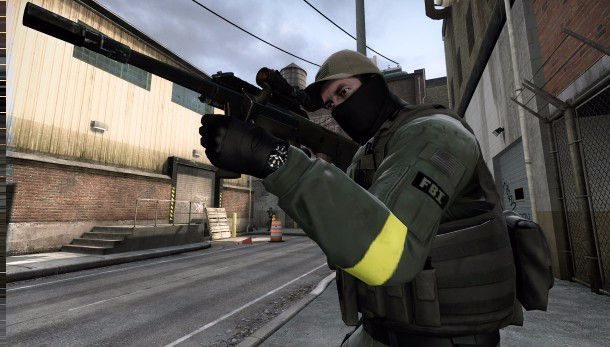
Every Monday, Evan writes about first-person shooters.
Playing a competitive online game means being subjected to a certain amount of unsolicited criticism. I think you receive a bit more of it in CS:GO, though, because your dead teammates form a kind of peanut gallery who can talk to you from beyond the grave. Being the last one alive as four other players hover over your digital shoulder is a quintessential CS experience.
I’ve been that digital shoulder hundreds of times, struggling to clutch while a person I’ve never met tells me which gun I should grab to retake Nuke’s A bombsite, or chastises me for using a grenade in a one-on-one situation. It’s annoying, but I’m actually grateful for a lot of the harsh feedback that’s been handed to me in these moments because it’s shaken me out of some bad habits.
Below, a selection of some of the criticism that’s been condescendingly muttered at me in CS that turned out to be great advice:
“Don’t reload.”
Shooters, single-player shooters especially, condition us to reload as a Pavlovian response to getting a kill. Resisting that urge is one of the first things most new CS players have to unlearn. Most weapons in CS:GO take between two and four seconds to reload: plenty of time for someone to peek around a corner or move through the space you should be defending. But maybe more importantly, in close-quarters, reloading betrays your position with sound. Consider the trade-off: would you rather have a full mag and an enemy who knows where you are, or a shallow mag and an enemy who’s out of position?
Don’t underestimate how much you can do with four or five bullets. With a rifle, it takes three or four non-headshots to take an enemy from full health to none—and in late-game situations, it’s even less likely that the enemy around the corner has 100 HP.
“Don’t pretend.”
A few months ago one of my teammates in a match I’d solo queued into called me out on this. “What are you doing? I bet you saw that on Twitch or some shit, right?” He was right. I was “ADAD” spamming (quickly tapping A and D in alternation) to hold a corner on de_inferno. There was no purpose or tactical value to what I was doing, I was just miming something I’d seen in a tournament. It was the equivalent of doing a bunch of fancy dribbling in soccer with no one playing defense against me.
It’s great to experiment with stuff you see in competitive play, but understanding the situational benefits of each maneuver is a huge step toward pulling it off successfully. After the ESL, I started backing away from my own flashbang grenades on entries, something I loved seeing in that tournament. But then I realized that my grenade placement wasn’t nearly good enough to guarantee that I was flashing enemies at all—I was just imitating for the sake of imitating.
“Please, please don't throw that grenade.”
Put the pin back in. I see so much misplaced faith in the frag grenade in CS:GO, partly because I used to be that guy who’d start a bombsite retake with a frag toss, often coming around corners while still in the follow-through animation for the throw. Here’s what I learned, after someone finally scolded me: your frag isn’t going to kill anyone. Even if you’re the Joe Montana of grenades and toss directly into the enemy player’s mouth, it’ll do 57 damage. If you played a lot of CS:Source, where grenades did a max of 72 against armored opponents, take a moment to realize that a perfect toss will only inflict as much as about two bullets.
In almost all situations, but especially in one-on-ones, your rifle is going to be able to kill someone faster and more safely than any sort of offensive grenade. Flashes are handy in a lot of situations in CS, but they’re also unreliable: you can’t be sure how well you’ve blinded someone. If I had just kept my gun out instead of reaching for that 4 key, I would’ve won many more rounds for my team.
“Don't turn a three-on-one into a series of one-on-ones.”
This is the one I’ve started to preach most to players that I solo queue in Competitive mode with. It’s easy to take a round win for granted when you’re in a 3-on-1 or a 4-on-2. The easiest way to give away an easy win, though, is arranging your team in a way that the enemy can encounter you one at a time, on their own terms. When you’re defending a bombsite against a shorthanded enemy, your goal should be to guarantee a trade: put the enemy in a position where they must cross the firing line of Player B if they want to kill Player A.
“Are you afraid of your own pistol, or something?”
Pistols have an amazing amount of utility in CS:GO. In the current build, the CZ75—the only automatic pistol—has a ludicrous amount of value as a short-range, spray-and-hope-for-the-best gun when your AWP isn’t cutting it or your M4A1-S runs dry. Even with the recent change to price it at $500, the cost of two grenades, it’s a strong backup for serial AWPers who fear being rushed.
“Dude, why would you ever crouch-walk?”
This is ancient, ancient advice, but it’s something that I still occasionally see players doing on casual servers. Crouch-walking around a corner will always grant advantage to someone who’s watching that corner—they’ll always be able to see your gun poke out, then your knees, and blast you before you see them. If you need to check around an object, shoulder peek: dart out of cover while revealing as little of yourself as possible, then back in as quickly as possible, purely to see where an enemy is.



